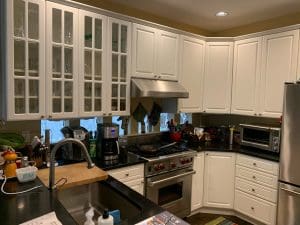
5 Ways to Improve Air Quality in Your Home This Winter
Clean is essential.
The air we breathe is an essential building block to good health. As the place where we spent most of our time, our homes require excellent indoor air quality to maintain overall wellness. While it may seem like you have no control over the air quality in your home, indoor air quality is, in fact, something you can control and optimize.
Through sustainable design choices, mindful home improvements, and simple lifestyle changes, you can enhance the air quality in your home and, in turn, improve your health this winter. Working with Certified Green Builders like Pathway Design and Construction for your home remodel is a great way to take the first step towards optimal living. Strategic and sustainable design works hand-in-hand with healthy habits to ensure the air quality in your home is helping you and your family thrive.
Here are the top 5 ways that you can improve indoor air quality to create a healthier home this winter:
Start by Testing the Air Quality in Your Home

Effective problem-solving starts with an assessment. While professional products and services can provide a framework to test the air quality in your home, there are also many signs you can watch out for that may indicate poor air quality. Do people in your home experience more sneezing, coughing, or watery eyes when they’re inside? This may be a sign of allergies or asthma exacerbated by the air quality in your home. The Environmental Protection Agency (EPA) provides a guide that highlights common household pollutants such as Radon, secondhand smoke, combustion pollutants, Volatile Organic Compounds (VOCs), and asthma triggers so you can identify which may be affecting your home. You can also buy an air quality monitor, which will test for a range of pollutants including carbon dioxide, carbon monoxide, and VOCs.
Older homes are often at a higher risk of having poor ventilation due to dated construction. If your home was built before the 1970s, it may contain lead-based paint which can be a health hazard if not properly contained. Lead poisoning can cause developmental problems in children, so if you live in an older home, it’s important to test for lead and take the necessary precautions when you make home improvements.
Ensure Optimal Ventilation in Your Living Spaces
One of the most effective ways to improve air quality is by ensuring that your living spaces are well ventilated. This may seem like an obvious solution, but many homes are not properly ventilated, which can cause a range of problems including condensation, and the accumulation of dust, mold, and other allergens. If you have central air conditioning, make sure that the air vents are clear of furniture or other obstructions that could block the flow of air. In winter, open the windows occasionally to let fresh air in and circulate the stale air that can build up indoors. If you have a fireplace, make sure that it’s properly ventilated to avoid carbon monoxide build-up.
Healthy home restorations focus on creating optimal airflow to reduce the chances of excess moisture and improve overall indoor air quality. As Seattle's first BIAW Certified Builder™, Pathway uses universal design principles during our home renovations to create living spaces that are both comfortable and functional, placing windows strategically to maximize natural light and ventilation. From our experience, small spaces often present the biggest challenge when it comes to ventilation. This is why we pay special attention to areas like basements and laundry rooms to ensure that they are properly ventilated to avoid moisture build-up. Cross-ventilation is an essential part of this strategy, maximizing the placement of windows and wall vents to promote consistent air flow.
Do you like home remodeling tips?
Remodeling your home can be a daunting experience. The Pathway team has taken the time and expertise to create podcast episodes detailing the tips and tricks of the trade.
Harness the Power of HVAC Filters
Your HVAC system is one of the most important tools you can have for maintaining indoor air quality. These systems work to circulate and filter the air in your home but over time, the filters can become clogged with dust, pollen, and other allergens. This reduces the system’s efficiency and can cause the quality of the air in your home to deteriorate. To avoid this, it’s important to regularly check and replace your HVAC filters according to the manufacturer’s guidelines. For families with allergies or asthma, we recommend using HEPA filters which are designed to remove 99.97% of airborne particles.

If you're going through a home remodeling process, ensuring healthy living conditions during your home renovations should be a priority. Pathway is committed to keeping you and your family safe during your home remodel so you can forgo the cost of alternative accommodation during the project. Our team takes the necessary precautions to prevent construction dust and other allergens from circulating throughout your living space by using HVAC filters while we work. We also use green building materials, and low or no VOC paint, finishes, and adhesives to improve air quality during and after your home renovation.
Control Humidity Levels
Another important factor to consider when it comes to indoor air quality is humidity. Too much moisture in the air can lead to mold and mildew, which can cause respiratory problems. Conversely, too little humidity can cause dryness in the air, which can irritate your throat and sinuses. The ideal relative humidity level for most homes is between 30-50%. If you want to be sure, you can measure humidity levels accurately with a hygrometer, but if you find yourself sweating profusely in your home or unable to sleep due to congestion, it’s likely that the humidity levels are too high. If, on the other hand, your skin is dry, your lips are chapped, and your throat is always sore, the humidity levels are probably too low.
There are a few ways to control humidity in your home. If the levels are too high, you can use a dehumidifier to remove moisture from the air. You'll typically use a dehumidifier when the weather is humid (i.e., in the summer months). If the humidity levels are too low, you can use a humidifier to add moisture back into the air by releasing water vapor. You'll likely use a humidifier in the winter months when the air is drier. Pathway takes humidity levels into account when designing a sustainable home to ensure that the indoor air quality is optimal year-round so that you don't see sky-high energy bills from using appliances to control your home’s humidity levels.
Reduce Air Pollutants at the Source
The best way to achieve optimal indoor air quality is to take a comprehensive approach that includes developing healthy habits at home. Consistently good air quality depends on small lifestyle changes to support your healthy home restoration. Adopting practices that reduce the work your HVAC filter must do, keeps your home clean and safe:
Here are some simple but significant things you can do to make a difference:
- Pet fur and dander can be a source of indoor air pollution. Regular grooming curbs your fury-friend’s contribution to contaminants in the house.
- Indoor gardening is a known natural method of air filtration, bringing aesthetic value into your home while absorbing carbon dioxide and releasing oxygen.
- Adopting a ritual of cleaning your vents every few months also prevents the spread of dust and dirt, improving the circulation of fresh air in your home at the same time.
- When bringing chemicals and cleaning products into your home, opt for non-toxic, eco-friendly options. Pathway empowers our clients with knowledge around how to use green cleaning products so you can maintain a healthy space long after we've completed your home renovation.
Enhance Your Home’s Air Quality with Pathway
Lifestyle changes go a long way in reducing pollutants in your home and protecting your family's health, but if you're looking for a long-term solution to your indoor air quality challenges, Pathway can assist with optimizing your ventilation, filtration, and insulation to ensure that your home is as healthy and comfortable as possible.
A healthy home remodel is not only an investment in your and your family's wellbeing, but it will also see your energy bills decrease and the value of your home go up. Whether you have specific concerns about the indoor air quality in your home, or you want to talk through sustainable home design options, our team of experts will help you develop a custom remodeling plan that best suits your needs.
Contact our team of sustainable home builders to get started on creating a healthier, happier home.
